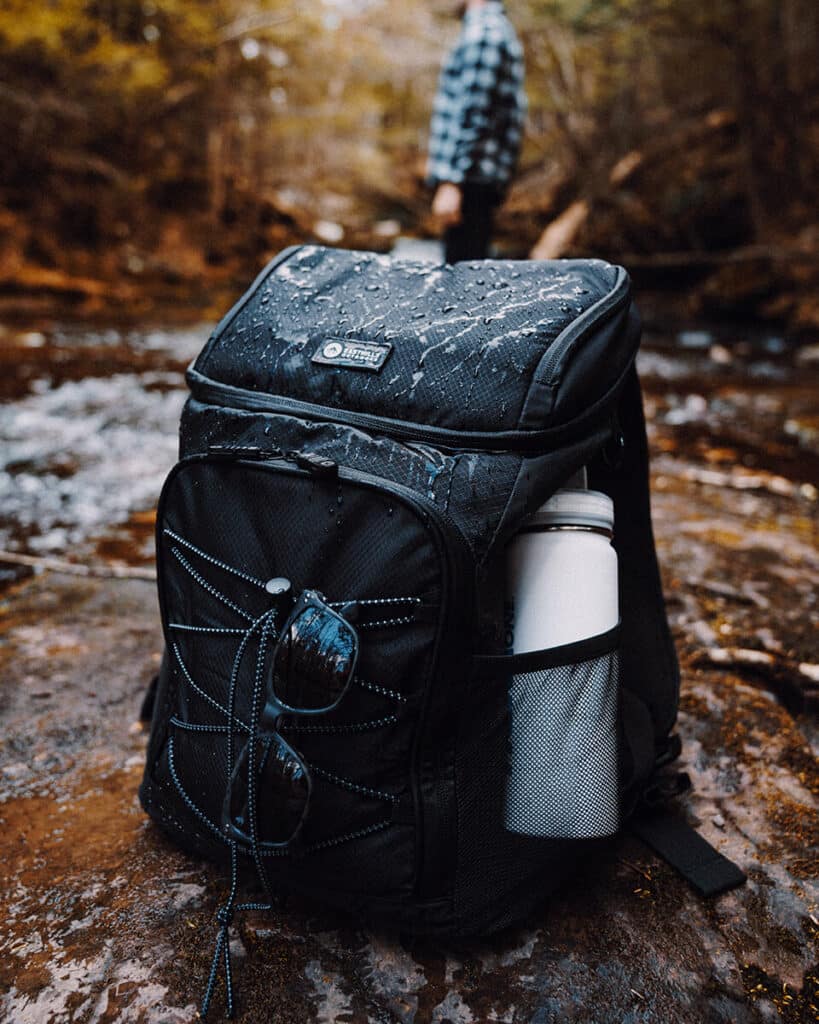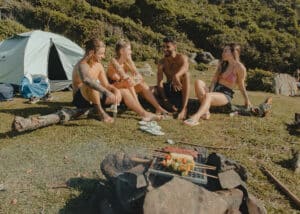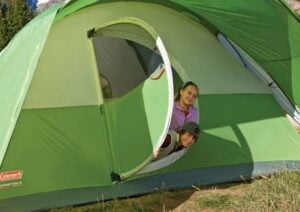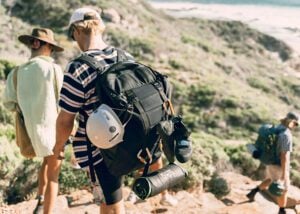So you want to go camping, but you’re worried about the possibility of bad weather? Well, don’t be! With a bit of preparation, you can make sure that even if the weather takes a turn for the worse, you’ll still have a great trip. Just follow these tips and you’ll be prepared for anything!
What to do if it rains while camping?
If it rains while camping, take the necessary precautions to ensure your safety and comfort. Be sure to protect your electronics from water damage, and make sure that you have adequate shelter and clothing. Most importantly, don’t let a little rain dampen your spirits – after all, there’s nothing like a cozy fire and a hot cup of coffee to make a rainy day just perfect.
1. Check the weather forecast before you pack your bags – and be prepared for changes

When camping in the rain, it is important to be prepared for changes in the weather. Checking the forecast before setting out can help you to pack the right gear and plan for any potential changes in the forecast.
If you know there’s a chance of thunderstorms, you can pack extra tarps and ropes to secure your tent. If there’s a risk of flash flooding, you can choose a campsite that’s on higher ground.
2. Pack extra clothes, including a raincoat and waterproof boots

There’s nothing worse than being caught in a rainstorm without an umbrella or getting stuck in the snow with wet socks.
A raincoat and waterproof footwear are essential for any hiker’s rain gear collection, even if the forecast is sunny. But don’t stop there: consider packing a hat, scarf, and extra jacket as well. And if you’re hiking in an area with lots of bugs, it’s a good idea to pack a long-sleeved shirt and pants.
With a little advance planning, you can be prepared for anything Mother Nature throws your way.
- RAINY ADVENTURES. Constructed with...
- STAY DRY. This waterproof jacket is...
- RELAXED FIT. Designed for versatile...
- PACKABLE DESIGN. You only need a...
- SECURE STORAGE. Covered secure zip...
- YEAR-ROUND STYLE. Featuring...
- STANDARD FIT. With a flattering...
- FACE THE WEATHER. Waterproof and...
- THOUGHTFUL DESIGN. Made with an...
- EXPLORATION WITHOUT COMPROMISE....
3. Choose a campsite that’s not susceptible to flooding.

You’ll want to find a spot that is relatively level, with good drainage. Steep slopes can be slippery when wet, and low-lying areas can flood easily. It’s also a good idea to avoid sites with large trees, as they can lose limbs in high winds.
Once you’ve found a suitable spot, it’s time to start pitching your tent. Make sure to choose a rainy campsite spot that is far enough away from any trees or other objects that could fall on your tent in the event of high winds.
If possible, set up your tent on top of an extra tarp or ground cloth to help keep the bottom dry. Need some ideas? Check out our list of best camping tarps. And finally, don’t forget to bring along some extra rope so that you can secure your tent in case of rainy weather.
4. Set up your tent on a slight incline, so water will run off
When setting up your tent, make sure to choose a spot that is on a slight incline. This will help to ensure that water runs off the sides of your tent, rather than pooling in the middle.
If you don’t have a lot of experience pitching tents, practice at home before you go camping, or check out our post on how to set up a tent. That way, you’ll be familiar with the process and won’t have to worry about it in the rain.
5. Make sure your tent is waterproof and well-sealed

Waterproofing your tent will help to keep you and your belongings and tent dry. It will also help to prevent the build-up of condensation inside the tent.
While you can buy tents that come with a waterproof coating, it’s also possible to waterproof your tent yourself. To do this, simply apply a sealant to all of the seams of your tent.
Be sure to apply the sealant evenly and allow it to dry completely before pitching your tent. Once your tent is waterproofed, make sure to check the seals regularly to ensure they are still intact.
6. Hang a tarp overhead to create a space for everyone to gather.
One of the best ways to stay dry is to hang a tarp overhead. This will create a space for everyone to gather and stay dry. The tarp will also help to keep the campsite clean and dry. A tarp can also be used to create a windbreak.
When hanging a tarp, be sure to use heavy-duty ropes or bungee cords. The tarp should be securely fastened so that it does not blow away in the wind. Be sure to choose a spot for the tarp that is level and free of debris. If the ground is wet, you may want to put down a ground cloth underneath the tarp.
7. Store your food in waterproof containers to keep it dry.
When you go camping, you want to be able to enjoy the outdoors and not worry about your food getting wet. Unfortunately, if you don’t store your food in waterproof containers, that’s exactly what could happen – and it would ruin your trip.
Wet food is not only unpleasant to eat, but it can also attract animals. Even worse, if the weather is warm, it could start to spoil and make you sick. To avoid these problems, it’s important to invest in some good waterproof containers for your next rainy camping trip. With these, you’ll be able to relax and enjoy the outdoors without worry. Plus, they’ll keep your food fresher longer, so you can even save money in the long run.
8. If it’s raining, cook inside your tent – or use a portable stove.

Another great way to stay dry is to cook inside your tent. If you have a portable stove, you can set it up inside the tent and cook without having to leave the comfort of your dry shelter. Check out this article on how to safely cook inside a tent.
If you don’t have a portable stove, you can still cook inside your tent. simply build a fire outside, and then bring the pot or pan inside the tent to cook. Be sure to keep the door of the tent open so that you can see what you’re doing, and be sure to extinguish the fire completely when you’re finished cooking.
9. Collect rainwater in buckets to use for washing dishes and bathing.
If you’re camping in the rain, you can collect rainwater in buckets to use for washing dishes and bathing. This will save you from having to haul water from a nearby stream or lake, and it will also help to conserve water.
To collect rainwater, simply set out some buckets or containers before it starts to rain. Be sure to put them in a spot where they will be able to catch the rainwater, such as under a tree or next to your tent.
10. Use hand warmers and foot warmers to stay warm and dry.
One of the best things you can do is to use hand warmers and foot warmers. These can be placed in your pockets or inside your sleeping bag to help you stay warm.
Foot warmers are especially useful for keeping your feet dry and comfortable. If your feet get cold, they will be more likely to sweat, and this can lead to blisters.
11. Drink plenty of water to stay hydrated.
It’s important to drink plenty of water when you’re camping, even if it’s raining. When you’re active and in the outdoors, you lose a lot of water through sweating.
If it’s cold, you may not feel as thirsty, but it’s still important to stay hydrated. Drinking plenty of water will help your body to function properly and will keep you from getting dehydrated.
12. Avoid hiking in the rain, as slick rocks can be dangerous.
While hiking in the rain may sound like fun, it can actually be quite dangerous. Slick rocks can be very slippery, and if you’re not careful, you could fall and hurt yourself.
If you must hike in the rain, be sure to wear proper footwear with good traction. Also, take your time and be extra careful on slippery sections of the trail.
13. Make a clothesline to dry wet clothes – use paracord or rope

If your clothes get wet, you can make a clothesline to dry them. This is especially useful if you don’t have a place to hang them inside your tent.
To make a clothesline, simply tie a rope or paracord between two trees. Then, hang your wet clothes on the line. If it’s windy, the clothes will dry quickly. If it’s not windy, you can place a fan near the clothesline to help them dry.
- Those who understand the trouble of...
- What makes it unique is the black...
- Used to hang different types of...
- Hawatour Portable Travel...
- It's elastic and can be stretched...
14. Bring some sort of tinder or fire starter – Instafire is a great option
No one wants to be stuck in the rain without a fire. Not only is it cold and miserable, but it can also be dangerous. Without a fire, you won’t be able to cook food or boil water, and you’ll be at risk for hypothermia.
That’s why it’s always important to bring tinder or firestarter when camping in the rain. You never know when you might need it, and it could mean the difference between a fun camping trip and a disaster. There are lots of different ways to start a fire, so make sure you’re prepared by reading our article on how to build a campfire before you head out into the wilderness.
- Made in USA *** CAMPING FIRMade in...
- NO HARMFUL CHEMICALS Unlike cubes...
- GUARANTEE: The Instafire Team has...
- NON-VOLATILE, SAFE STORAGE AND...
- AS SEEN ON SHARK TANK! Perfect for...
15. Pack some waterproof matches or a lighter
If you’re going to be camping in the rain, you need to be prepared to start a fire. Waterproof matches or a lighter is essential for this, as they will allow you to start a fire even if everything else is wet.
There are lots of different ways to start a fire in the rain, but matches or a lighter is the easiest and most foolproof method. If you don’t have either of these, you can try using a Ferro rod. This is a steel rod that produces sparks when struck against a hard surface.
- Includes 25 windproof and...
- Matches are easy to light, will...
- Waterproof, durable ABS plastic...
- Extended length of match allows for...
- Length of matches: 2.75 inches (7...
16. Keep your campsite tidy to avoid attracting bugs and rodents.
No one likes dealing with bugs and rodents when they’re trying to enjoy a camping trip. Unfortunately, those pesky creatures are often attracted to messy campsites. That’s why it’s important to keep your campsite tidy if you’re camping in the rain.
Make sure to put away all food items, dispose of trash properly, and clean up any spills right away. You should also store your firewood off the ground and away from your tent.
17. Make sure your cell phone is fully charged in case of an emergency.
Having a cell phone can be a lifesaver when you’re camping in the rain. Not only can you use it to call for help if someone is injured, but you can also use it to keep track of the rainy weather and make sure that you’re not in danger of being caught in a flash flood.
A cell phone can also be a great way to stay connected with friends and family while you’re away from home. And if you have kids with you, it’s always good to have a way to reach them if they wander off. So make sure that your cell phone is fully charged before you head out into the wilderness – it could be the difference between a great camping trip and a dangerous one.
18. Pack a first-aid kit in case anyone gets injured.
Camping in the rain can be fun, but it’s important to be prepared in case anyone gets injured. A first-aid kit is a necessity for any camping trip, but it’s especially important when there is a chance of rain.
Wet conditions can make injuries more difficult to treat, and mud can create a slipping hazard. By packing a first-aid kit, you can be sure that you have the supplies you need to treat any injuries that may occur. Be sure to include items like bandages, antibiotic ointment, and pain relievers. In addition, it’s always a good idea to pack extra clothes and towels in case anyone gets wet.
- Comprehensive Emergency Kit:...
- Convenient Packaging: An ideal...
- Easy Access: This convenient and...
- Compact Size: Small enough to fit...
- Personal and Professional First Aid...
19. Set up a pop up shelter canopy for added coverage

If you’re camping in the rain, a pop-up canopy can be a lifesaver. It will provide you with extra coverage from the elements, and it can also be used as a place to store wet clothes or gear. See our top recommendations for pop-up canopy shelters in wind and rain.
A pop-up canopy is also great for keeping your campsite tidy. By setting up a canopy, you can create a designated area for cooking, eating, and relaxing. This will help to keep your campsite clean and organized, and it will make your trip more enjoyable.
20. Come prepared with rainy day camping activities to help pass the time
If you’re stuck inside due to bad weather, it’s important to have some activities to help pass the time. Board games, books, and magazines are all great options. And if you have kids with you, make sure to bring along some toys and coloring books to keep them entertained.
21. Don’t forget the marshmallows – rain or shine, s’mores are always a hit.

No camping trip is complete without s’mores, so make sure to pack them even if you’re expecting bad weather. S’mores are the perfect rainy day treat, and they can be made indoors or outdoors.
All you need are some graham crackers, chocolate, and marshmallows. If you’re making them indoors, you can use a microwave or stovetop to melt the chocolate and toast the marshmallows. Or, if you’re feeling adventurous, you can try making them over a campfire. Just be sure to keep an eye on the weather and make sure that it’s safe to build a fire before you get started.
22. If the rain is really coming down, try to find some shelter to wait it out.
If the rain is coming down hard, it’s best to find some natural shelter and wait it out. This can be a challenge if you’re camping in the rain, but it’s important to stay safe and dry.
If you have a pop-up canopy, this can provide you with some protection from the rain. Otherwise, you can try to find a nearby cave or overhang. If you can’t find any shelter, try to make your own by covering yourself with a tarp or blanket.
23. Make sure you bring a good tent with a rainfly.
A good tent is essential for any camping trip, but it’s even more important when you’re expecting bad weather. Make sure to choose a tent that’s made from waterproof material, and be sure to set it up properly.
Most tents come with a rainfly, which is a piece of fabric that goes over the top of the tent to provide extra protection from the elements. Be sure to attach the rainfly before you go to sleep, and be sure to take it down in the morning so that your tent can dry out.
Some of our favorite weatherproof tents are provided by Coleman:
Check out the Coleman WeatherMaster 10-person tent for large groups [OUR REVIEW]
- Cabin-like 10-person tent has...
- WeatherTec system with patented...
- Hinged front door for easy entry...
- Sets up easily in 20 minutes
- Measures 17 x 9 feet with 6-foot...
Or the Coleman Montana 8-person tent for more family-friendly features [OUR REVIEW]
- Large 8-person tent with built-in...
- WeatherTec system with patented...
- Extended door awning keeps shoes...
- Measures 16 x 7 feet with 6-foot...
- Rainfly included for weather...
24. Stay away from dangerous areas like riverbanks and cliffs.
If you’re camping in an area that’s prone to flooding, it’s important to stay away from dangerous areas like riverbanks and cliffs. These areas can be unstable during heavy rains, and they can pose a serious threat to your safety.
If you’re unsure about the stability of an area, it’s best to err on the side of caution and avoid it altogether.
Related: Check out our top picks on the best tents for heavy rain
25. Consider buying a tent with a vestibule

A vestibule is a small, covered area that’s attached to the front of a tent and covers the tent door. It’s typically used as a storage area for wet gear or shoes.
If you’re expecting bad weather, a vestibule can be a great way to keep your tent clean and dry. It’s also a good place to store wet clothes or gear so that it doesn’t get your sleeping area wet.
26. Bring a waterproof backpack to keep your belongings dry.

A waterproof backpack is a must-have to add to your camping rain gear collection to bring on any camping trip, but it’s especially important when you’re expecting wet weather. This will help to keep your belongings dry, no matter what the conditions are like.
There are a variety of different waterproof backpacks on the market, so be sure to choose one that’s right for you. And if you’re planning on hiking in the rain, be sure to pack a few extra bags in case your backpack gets wet.
27. Wear the right amount of layers
Clothing choices can be the difference between a miserable hike and an enjoyable one. Layering clothes is always a good idea, regardless of the season. In warm weather, hikers can peel off layers to avoid overheating. In cold weather, hikers can add layers to stay warm.
But what about when the weather is unpredictable? If you’re hiking in an area with a chance of rain, it’s best to err on the side of too many layers. Waterproof outer layers are always a good idea, as they can help to keep you dry if you get caught in a downpour. And if the weather is cold and wet, make sure to pack a hat, gloves, and a warm jacket.
28. If you hear thunder, that means a storm is close by – seek shelter immediately.
If you’re camping in an area with a chance of thunderstorms, it’s important to be aware of the dangers they pose. If you hear thunder, that means a storm is close by. Seek shelter immediately and wait for the storm to pass.
Thunderstorms can cause dangerous flooding, so it’s important to avoid areas that are prone to flooding. And if you’re caught in a thunderstorm, stay away from tall objects like trees and power lines.
29. If lightning strikes, crouch down low to the ground and avoid touching anything metal.
Lightning strikes are one of the most dangerous aspects of thunderstorms. If you’re caught in a thunderstorm, crouch down low to the ground and avoid touching anything metal. This will help to reduce your risk of being struck by lightning.
And if you see someone who’s been struck by lightning, call for help immediately and start CPR if they’re not breathing.
30. Remember that animals are stressed by bad weather too – be gentle with them.

Bad weather can be tough on everyone, including animals. If you’re camping with pets, remember that they may be stressed by the bad weather. Be gentle with them and give them plenty of time to adjust to the change in conditions.
And if you’re hiking in an area with wildlife, be aware that they may be more active during bad weather. Take caution and give them plenty of space.
31. Be aware of the signs of hypothermia and frostbite.
Hypothermia is a condition that occurs when your body temperature drops below 95 degrees Fahrenheit. Symptoms of hypothermia include shivering, confusion, and slurred speech.
Frostbite is a condition that occurs when your skin and tissues freeze. Symptoms of frostbite include numbness, white or pale skin, and hard or waxy-looking skin.
If you notice any of these symptoms, seek medical attention immediately.
Recap and Further Reading
So, what do all of these tips have in common? They’re all ways to help you stay safe and comfortable while camping in the rain. And remember, even if the weather is unpredictable, it’s always a good idea to pack a few extra layers. Stay safe and have fun on your next camping trip!
FAQ
What to do if it rains while camping?
If it rains while you’re camping, the best thing to do is to seek shelter and wait for the storm to pass. If you have a tent, set it up and wait out the rain. If you don’t have a tent, look for a nearby building or cave where you can take shelter in. Need a tent? We recommend shopping around for a versatile 3-season camping tent.
Is it worth it to camp in the rain?
Camping in the rain can be a great experience, as long as you’re prepared for it. Make sure to pack the right gear and clothes, and be aware of the dangers of thunderstorms. If you take these precautions, you’ll be able to enjoy your camping trip even if the weather isn’t perfect.
How do you camp in the rain without being miserable?
The key to camping in the rain without being miserable is to be prepared. Pack the right gear, dress in layers, and be aware of the dangers of thunderstorms. If you take these precautions, you’ll be able to enjoy your camping trip even if the weather isn’t perfect.
How do you sleep in a tent when it’s raining?
If you’re camping in a tent and it starts to rain, the best thing to do is to seek shelter and wait out the storm. If you have a waterproof tent, set it up and wait out the rain. If you don’t have a waterproof tent, look for a nearby building or cave where you can take shelter in.
Should I cancel camping because of rain?
Whether or not you should cancel your camping trip because of rain depends on the forecast and how prepared you are for bad weather. If the forecast is calling for severe weather, it’s probably best to cancel your trip. But if you’re prepared for rain, there’s no need to let a little precipitation ruin your fun.













